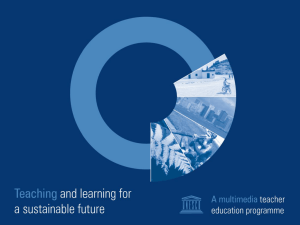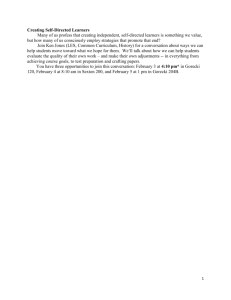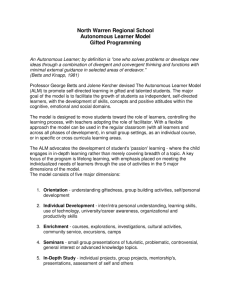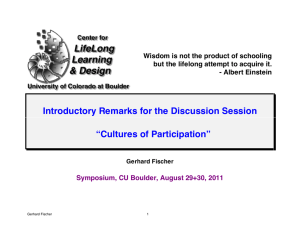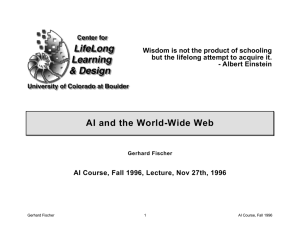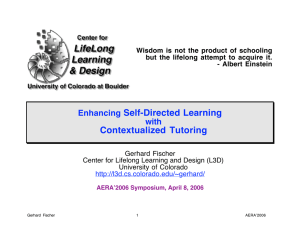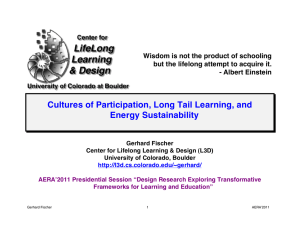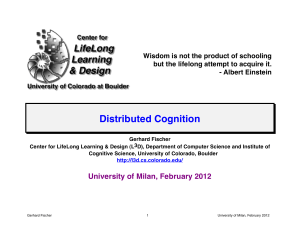University of Colorado at Boulder
advertisement
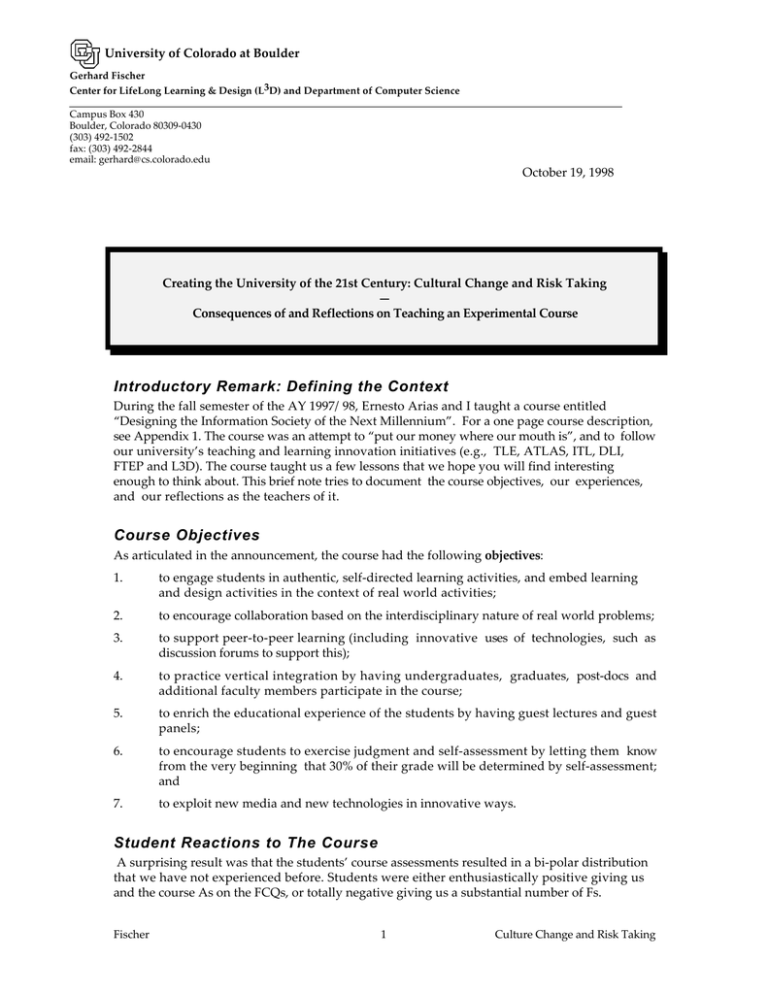
University of Colorado at Boulder Gerhard Fischer Center for LifeLong Learning & Design (L3D) and Department of Computer Science Campus Box 430 Boulder, Colorado 80309-0430 (303) 492-1502 fax: (303) 492-2844 email: gerhard@cs.colorado.edu October 19, 1998 Creating the University of the 21st Century: Cultural Change and Risk Taking — Consequences of and Reflections on Teaching an Experimental Course Introductory Remark: Defining the Context During the fall semester of the AY 1997/98, Ernesto Arias and I taught a course entitled “Designing the Information Society of the Next Millennium”. For a one page course description, see Appendix 1. The course was an attempt to “put our money where our mouth is”, and to follow our university’s teaching and learning innovation initiatives (e.g., TLE, ATLAS, ITL, DLI, FTEP and L3D). The course taught us a few lessons that we hope you will find interesting enough to think about. This brief note tries to document the course objectives, our experiences, and our reflections as the teachers of it. Course Objectives As articulated in the announcement, the course had the following objectives: 1. to engage students in authentic, self-directed learning activities, and embed learning and design activities in the context of real world activities; 2. to encourage collaboration based on the interdisciplinary nature of real world problems; 3. to support peer-to-peer learning (including innovative uses of technologies, such as discussion forums to support this); 4. to practice vertical integration by having undergraduates, graduates, post-docs and additional faculty members participate in the course; 5. to enrich the educational experience of the students by having guest lectures and guest panels; 6. to encourage students to exercise judgment and self-assessment by letting them know from the very beginning that 30% of their grade will be determined by self-assessment; and 7. to exploit new media and new technologies in innovative ways. Student Reactions to The Course A surprising result was that the students’ course assessments resulted in a bi-polar distribution that we have not experienced before. Students were either enthusiastically positive giving us and the course As on the FCQs, or totally negative giving us a substantial number of Fs. Fischer 1 Culture Change and Risk Taking This reaction is best illustrated by two comments, quoted from the students’ self-evaluations: 1. a negative comment : “I will not ever take a course of this nature again in my undergraduate career, and I hope to find a more structured graduate program with an adviser that is more forthcoming. I will reinforce my strengths by continuing to study in the method that I have developed over the past 15 years, I will redirect my weaknesses by avoiding unstructured class environments. I believe that the type of selfdirected learning that this class wished to promote is better done during independent studies and thesis work. (I am involved in both of the above in a very self-directed environment, I am doing well and the concept work much better there.)” 2. a positive comment: “When I signed up for this class I had no idea what it was going to be about. Once I started understanding the material, however, I was extremely thrilled and interested to be a part of one of the most progressive courses on campus. I'm not sure what specifically to say except that I rank this class in the top three that I've taken at CU. The self-directed nature of the work ensured that I wouldn't be bored or unchallenged, and the interplay between all of us was a lot of fun. After four and a half years in college, I can honestly say that this is one of the first courses where I was treated as an adult, a fact which means more to me than I can describe.” Overall, the course was rated as a “C+”, and I as an instructor got a “C” - reflecting the bi-polar reactions of the students. Why the Student Reactions May be of some Interest? Because this was a new course with respect to (1) the teaching and learning approach, (2) content, and (3) innovative use of new media and technologies, Ernesto Arias and I spent substantially more time on this course than we do on a “normal” course. In addition, we used additional substantial resources (e.g., leaders of our campus in panel discussions, visiting faculty members, post-docs and graduate students to participate in the discussion forums and to demonstrate innovative use of technology). Consequently, we were disappointed by the students’ reactions to the course. What Can We Learn From The Student Reactions? The objective of this note is not to whine about our own experience, rather it is to ask whether some more general lessons can be learned from this event for innovating and changing our university to provide an exciting, challenging, and rewarding intellectual environment for our students and our teachers in the next millennium. The following are a number of claims derived from this event: • C1: Cultural change beyond the introduction of new technologies is required to achieve our university goals as articulated in initiatives such as TLE, ATLAS and DLI. There is a need for new assessment techniques to reflect the innovations that the university is purportedly trying to further through its initiatives, and the university needs to assess the impact of these changes and implement them on a system-wide level rather than piecemeal. • C2: Risk taking is not rewarded by the students. With current assessment instruments (such as FCQs serving as primary instruments), it is not rewarded by the institution, and as a result is potentially a dangerous undertaking by young, untenured faculty members. • C3: Change agents are needed, but they must be aware that they take risks. These risks may “force” especially young faculty members to accommodate the existing system and conduct business as usual. Fischer 2 Culture Change and Risk Taking Cultural Change Course Philosophy The basic course philosophy can be summarized as follows: 1. it was an attempt to overcome the impoverished conception that a course provides a learning experience in which an omniscient teacher explicitly tells or shows presumably unknowing learners something they presumably know nothing about; 2. it tried to reconcile the classroom as a community of mutual learners, in which the roles of the teachers and learners were not assigned to specific persons, but to specific contexts; the teachers acted as “guides on the side” rather than as “sages on the stage” and learners were given many opportunities to be active contributors; 3. the topic of this course “Designing the Information Society of the Next Millennium” seemed to particularly suited to this objective; we wanted to make students aware that the “future is not out there to be discovered, but invented and designed” — and that this future is more their future than the instructors’ future; 4. it tried to facilitate peer-to-peer learning, supported by innovative technologies such as discussion forums and the use of smart classrooms. This objective led to student reactions such as: 5. 4.1. “why should I learn from a peer when the faculty member knows the answer so much better”? 4.2. “why should I pay fees if the teacher is not willing to provide me with the answer?”; it promoted self-evaluation with the idea in mind that students should acquire skills to assess their own contribution and their own performance. What are students used to There is overwhelming evidence in the self-assessment and the FCQs comments of the students and from many of their reactions in class, that this course was a “culture shock” for almost all students. Most students behavior is grounded in the following beliefs: 1. they consider themselves as consumers of education (confirming Illich’s argument in his book “Deschooling Society” that “schools and universities are the reproductive organs of a consumer society”; 2. they believe that problems have an answer and that the teacher has to know the answer; 3. they are at best not interested and at worst unwilling to engage in peer-to-peer learning (which should not surprise us in a culture in which collaboration is mostly treated as “cheating”); 4. they are driven to learn primarily by the desire to get a good grade rather than by interest, passion, enjoyment derived from intrinsic motivation in learning. 5. they are not used to being assessed by anyone other than their teachers and therefore they need to learn how to self-assess — which, like any other skill, takes time to develop (we have probably made an insufficient effort in our course to “educate” students in this skill). Fischer 3 Culture Change and Risk Taking Risk Taking Cultural change will not take place without risk takers. The big questions are: 1. is our university aware of the numerous risks associated with cultural change? 2. does our university reward or punish (intentionally or unintentionally) risk taking among its faculty members? 3. do we understand the “risks” as they are perceived by the students (e.g.: (i) the course taught by us may have required that students spend more time and energy on it than on a traditional course; (ii) it may have confronted students with an unfamiliar environment causing fear and insecurity)? Risk taking is a consequence of different cultures clashing with each other. I am illustrating this issue here with one specific example: the “mismatch problem” between teachers and learners in teacher-driven/instructionist vs. self-directed/constructionist learning environments, as summarized in the table below. Teacher Student Example authority (“sage on the stage”) Dependent, passive lecture without questions, drill motivator and facilitator Interested lecture with questions, guided discussion Delegator Involved group projects, seminar coach/critic (“guide on the side”) self-directed, discoveryoriented self-directed study group, apprenticeship, dissertation (This table is a modified version of a table which appeared in: Grow, Gerald O. (1991/1996). "Teaching Learners to be Self-Directed." Adult Education Quarterly, 41 (3), 125-149. Expanded version available online at: http://www.famu.edu/sjmga/ggrow). The major mismatches which can be derived from this table are: 1. dependent, passive learners take courses with non-directive teachers, and 2. self-directed, discovery-oriented active learners take courses with directive, authoritarian teachers. The experience from our course was a mismatch of the first kind with at least half of the student population in the course. Conclusions — Issues to Be Aware Of Let us emphasize again (to make sure that this note is not misunderstood): the point here is not to assign blame, but to understand some important processes at work in attempting to change our university. Risk Taking. To change a culture is risk taking. In order to make progress towards the goals as articulated in TLE, ATLAS and DLI, the university needs to reward risk taking. Using FCQs as major instrument for assessment will punish risk taking (at least it will create this possibility). In all the CU committees I have served on over the last twelve years, there was universal agreement that FCQs are relevant, but they should definitely not be the only indicators of someone’s effort and engagement in innovative teaching, in integrating teaching and learning, and in creating rewarding learning experiences for the students. FCQ ratings get decontextualized as they are passed up in CU’s bureaucracy and in the end only an A, B, C or D Fischer 4 Culture Change and Risk Taking will count. Maybe CU needs some “high level change agents” who would identify, assist, protect and reward risk takers among the faculty? Based on the analysis of this note, I do not know what I should recommend serving as a mentor to a young faculty member about risk taking and innovations in their career? The ATLAS effort claims that CU’s approach will be different because of a real emphasis on assessment. I believe that this is a very laudable goal — and I hope that some of the issues raised in this note will serve as valuable input for their thinking. Cultural Change. New media and new technology provide us with new exciting possibilities to rethink our mission. But almost all serious educational reformers believe that new media and new technology on their own cannot transform universities to meet the demands of the future . Technology is only one part of cultural change. This implies that • the TLE goal-1 “Supporting innovations in learning, including both undergraduate and graduate education”, and • the TLE goal-3 “Using technology to improve teaching, learning, research, and management” have to be tightly integrated. Cultural change implies that all stakeholders participating in the process of change have to reflect and possibly change their behavior, their objectives, and their values. In the days where the future of universities are seen by many in the virtual world, where education is often reduced to a commodity, we need to understand the core competencies of a residential university. It is my strong belief that some of these core competencies –should be centered around the notion that instructionist learning will be complemented with self-directed learning; and that students of all ages will be involved in apprenticeship-like relationships which will allow them to become members of the community of scholars, researchers, proficient professional and educated persons. In summary, cultural change beyond the adoption of new technologies is required in our current system in which students have been taught to take on the role of consumers of education. This change will require risk taking by faculty members. The university needs to reward such risk taking rather than punish it. Additional Material 1. about the course (for readers who want to have a look at the details) 2. 1.1. complete self-assessment statements from the students 1.2. comments and ratings of the FCQs articles (relevant to the topics raised in this note): 2.1. 2.2. 2.3. 2.4. 2.5. Fischer Eli M. Noam: “Electronics and the Dim Future of the University”, Science, Vol. 270, pp. 247-249, 10/13/95 John Seely Brown and Paul Duguid: "Universities in the Digital Age"; at: http://www.parc.xerox.com/ops/members/brown/papers/university.html Robin Wilson: “New Research Casts Doubt on Value of Student Evaluations of Professors”, in the Chronicle of Higher Education Gerhard Fischer: "Beyond 'Couch Potatoes': From Consumers to Designers", in Proceedings of the 3rd Asia Pacific Computer Human Interaction Conference, IEEE Computer Society, July 1998, pp 2-9 Gerhard Fischer: “Conceptual Frameworks and Innovative Computational Environments In Support of Self-Directed and Lifelong Learning”, Report for the German Bundesministerium für Bildung, Wissenschaft, Forschung und Technologie, 1998 5 Culture Change and Risk Taking Appendix 1: Course Description Fall Semester 1997—A New Cross-Disciplinary, Graduate, Undergraduate Future-Oriented Course (College of Architecture and Planning, Department of Computer Science, Center for LifeLong Learning & Design, Institute of Cognitive Science) Designing the Information Society of the Next Millennium Ernesto Arias (ernie@spot.colorado.edu) and Gerhard Fischer (gerhard@cs.colorado.edu) Course Numbers: 1. CS 4830 sec. 002 call# 14110 2. CS 7000 sec. 002 call# 14111 3. CRP 668 sec. 001 call# 74194 Times: Locations: Textbook: Computer Science Undergraduates Computer Science Gradutes Denver Campus Plan/Design Graduates Monday, 7:00-9:30 pm Integrated Teaching and Learning Laboratory (ITLL 1B50) Herbert Simon “Sciences of the Artificial”, 3rd Edition, MIT Press, 1996 Content and Global Objective What will the information society of the next millennium be like, and how will individuals and organizations behave? While it is clear that the future will be different from the past, there is really no consensus as to how innovations in information and communication media will affect the shape of our society in the next millennium. The pursuit of these concerns is the objective of the course. Focusing on the concepts of learning and design and their integration with technological innovations, the course will frame and seek resolution to questions such as: What will the physical and information spaces defining communities be like? Can we design them? What role can education play in their design? How should we view learning and its role in the design and evolution of both technological change and societal outcomes? The course will investigate themes such as: design in physical spaces (e.g., cities) and in informational spaces (software) and the relationship between them; (virtual) communities of practice and it will explore fundamental concepts such as: evolution, design and sustainability, descriptive and prescriptive elements in design, and the role of breakdowns and symmetry of ignorance. Approach and Audience The course will represent an opportunity to rethink learning and the framing of problems through new approaches. It will allow students to engage in authentic, self-directed learning activities, and embed learning and design activities in the context of real world activities. To account for the interdisciplinary nature of real world problems, we encourage students with different background knowledge, from a variety of disciplines and from different educational backgrounds to participate. Prerequisites and Requirements: Permission of Instructors You do not have to be a computer expert to join. If you are interested in the role of technology in our society, and if you are a creative, critical and self-motivated graduate or undergraduate student who believes in interdisciplinary learning and who is concerned with the shape and the shaping of our future society, you should join us. Fischer 6 Culture Change and Risk Taking

